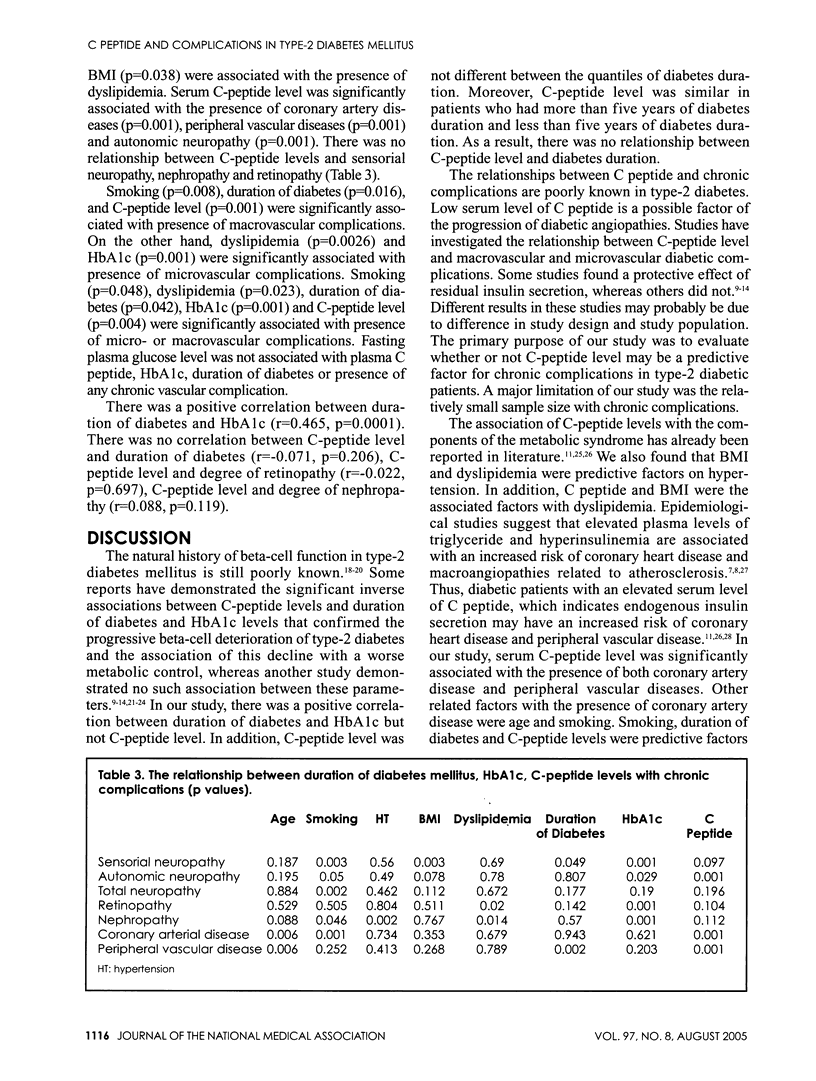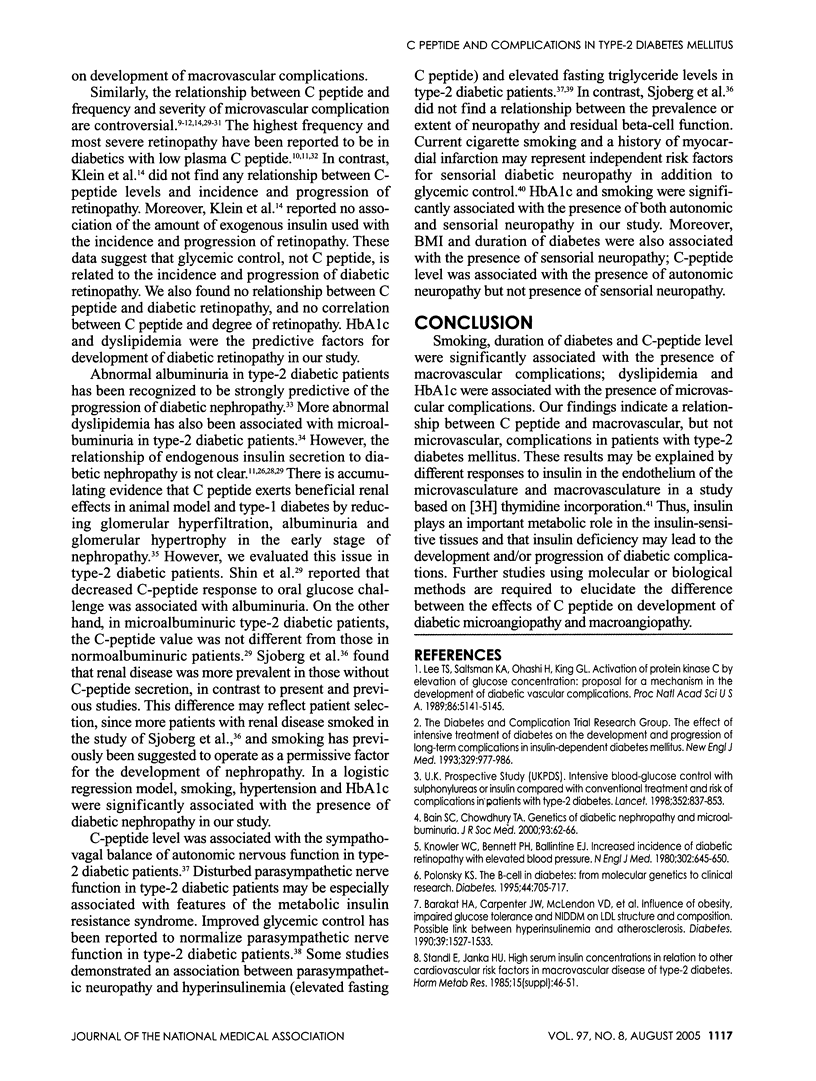Abstract
OBJECTIVE: The relationship between C peptide and micro- and macrovascular complications is poorly known in type-2 diabetes mellitus. The aim of the study was to evaluatethe relationship between serum C-peptide level and chronic complications in patients with type-2 diabetes mellitus. PATIENTS AND METHODS: Three-hundred-eighteen patients (138 male, 180 female) with type-2 diabetes mellitus were included in the study. Microvascular (nephropathy, retinopathy and neuropathy) and macrovascular complications (coronary artery disease and peripheral vascular disease) were determined in all patients. In addition, presence of hypertension and smoking habit was recorded. Fasting serum glucose, lipid levels, HbA1c and C-peptide levels were measured in all patients. RESULTS: There were 90 (28.3%) patients with sensorial neuropathy, 48 (15.1%) with autonomic neuropathy, 72 (22.7%) with nephropathy, 84 (26.4%) with retinopathy, 135 (42.5%) with hypertension, 270 (84.9%) with dyslipidemia, 33 (10.4%) with coronary artery disease and 18 (5.7%) with peripheral vascular disease. Serum C-peptide level was higher in patients with dyslipidemia (p = 0.045), hypertension (p = 0.001), coronary artery disease (p = 0.001), peripheral vascular disease (p = 0.001) and autonomic neuropathy (p = 0.001). Serum C-peptide level was not significantly different in patients with and without sensorial neuropathy, nephropathy and retinopathy. Serum C-peptide level was significantly associated with the presence of coronary artery disease (p = 0.001), peripheral vascular disease (p = 0.001) and autonomic neuropathy (p = 0.001). There was no relationship between C peptide and sensorial neuropathy, nephropathy and retinopathy. CONCLUSION: Our findings indicate a relationship between C peptide and macrovascular but not microvascular compli cations in patients with type-2 diabetes mellitus.
Full text
PDF





Selected References
These references are in PubMed. This may not be the complete list of references from this article.
- Austin M. A. Plasma triglyceride and coronary heart disease. Arterioscler Thromb. 1991 Jan-Feb;11(1):2–14. doi: 10.1161/01.atv.11.1.2. [DOI] [PubMed] [Google Scholar]
- Bain S. C., Chowdhury T. A. Genetics of diabetic nephropathy and microalbuminuria. J R Soc Med. 2000 Feb;93(2):62–66. doi: 10.1177/014107680009300204. [DOI] [PMC free article] [PubMed] [Google Scholar]
- Barakat H. A., Carpenter J. W., McLendon V. D., Khazanie P., Leggett N., Heath J., Marks R. Influence of obesity, impaired glucose tolerance, and NIDDM on LDL structure and composition. Possible link between hyperinsulinemia and atherosclerosis. Diabetes. 1990 Dec;39(12):1527–1533. doi: 10.2337/diab.39.12.1527. [DOI] [PubMed] [Google Scholar]
- Bo S., Cavallo-Perin P., Gentile L., Repetti E., Pagano G. Relationship of residual beta-cell function, metabolic control and chronic complications in type 2 diabetes mellitus. Acta Diabetol. 2000;37(3):125–129. doi: 10.1007/s005920070014. [DOI] [PubMed] [Google Scholar]
- Boz M., Scheen A. J., Gerard P. L., Castillo M. J., Lefebvre P. J. Retinopathy, but not neuropathy, is influenced by the level of residual endogenous insulin secretion in type 2 diabetes. Diabete Metab. 1995 Dec;21(5):353–359. [PubMed] [Google Scholar]
- Brichard S. M., van den Abbeele E., Ketelslegers J. M., Lambert A. E. Home blood glucose monitoring, glycosylated hemoglobin and fructosamine: their relationships in diabetic patients with and without residual C-peptide secretion. Diabete Metab. 1989 Nov-Dec;15(6):388–393. [PubMed] [Google Scholar]
- Clauson P., Linnarsson R., Gottsäter A., Sundkvist G., Grill V. Relationships between diabetes duration, metabolic control and beta-cell function in a representative population of type 2 diabetic patients in Sweden. Diabet Med. 1994 Oct;11(8):794–801. doi: 10.1111/j.1464-5491.1994.tb00355.x. [DOI] [PubMed] [Google Scholar]
- Every N. R., Boyko E. J., Keane E. M., Marshall J. A., Rewers M., Hamman R. F. Blood pressure, insulin, and C-peptide levels in San Luis Valley, Colorado. Diabetes Care. 1993 Dec;16(12):1543–1550. doi: 10.2337/diacare.16.12.1543. [DOI] [PubMed] [Google Scholar]
- Ewing D. J., Martyn C. N., Young R. J., Clarke B. F. The value of cardiovascular autonomic function tests: 10 years experience in diabetes. Diabetes Care. 1985 Sep-Oct;8(5):491–498. doi: 10.2337/diacare.8.5.491. [DOI] [PubMed] [Google Scholar]
- Feldt-Rasmussen B., Mathiesen E. R., Hegedüs L., Deckert T. Kidney function during 12 months of strict metabolic control in insulin-dependent diabetic patients with incipient nephropathy. N Engl J Med. 1986 Mar 13;314(11):665–670. doi: 10.1056/NEJM198603133141101. [DOI] [PubMed] [Google Scholar]
- Gottsäter A., Ahmed M., Fernlund P., Sundkvist G. Autonomic neuropathy in Type 2 diabetic patients is associated with hyperinsulinaemia and hypertriglyceridaemia. Diabet Med. 1999 Jan;16(1):49–54. doi: 10.1046/j.1464-5491.1999.00001.x. [DOI] [PubMed] [Google Scholar]
- Groop L., Ekstrand A., Forsblom C., Widén E., Groop P. H., Teppo A. M., Eriksson J. Insulin resistance, hypertension and microalbuminuria in patients with type 2 (non-insulin-dependent) diabetes mellitus. Diabetologia. 1993 Jul;36(7):642–647. doi: 10.1007/BF00404074. [DOI] [PubMed] [Google Scholar]
- Haupt E., Haupt A., Herrmann R., Benecke-Timp A., Vogel H., Walter C. The KID Study V: the natural history of type 2 diabetes in younger patients still practising a profession. Heterogeneity of basal and reactive C-peptide levels in relation to BMI, duration of disease, age and HbA1. Exp Clin Endocrinol Diabetes. 1999;107(4):236–243. doi: 10.1055/s-0029-1212106. [DOI] [PubMed] [Google Scholar]
- Inukai T., Matsutomo R., Tayama K., Aso Y., Takemura Y. Relation between the serum level of C-peptide and risk factors for coronary heart disease and diabetic microangiopathy in patients with type-2 diabetes mellitus. Exp Clin Endocrinol Diabetes. 1999;107(1):40–45. doi: 10.1055/s-0029-1212071. [DOI] [PubMed] [Google Scholar]
- King G. L., Buzney S. M., Kahn C. R., Hetu N., Buchwald S., Macdonald S. G., Rand L. I. Differential responsiveness to insulin of endothelial and support cells from micro- and macrovessels. J Clin Invest. 1983 Apr;71(4):974–979. doi: 10.1172/JCI110852. [DOI] [PMC free article] [PubMed] [Google Scholar]
- Klein R., Klein B. E., Moss S. E. The Wisconsin Epidemiologic Study of Diabetic Retinopathy. XVI. The relationship of C-peptide to the incidence and progression of diabetic retinopathy. Diabetes. 1995 Jul;44(7):796–801. doi: 10.2337/diab.44.7.796. [DOI] [PubMed] [Google Scholar]
- Klein R., Moss S. E., Klein B. E., Davis M. D., DeMets D. L. Wisconsin Epidemiologic Study of Diabetic Retinopathy. XII. Relationship of C-peptide and diabetic retinopathy. Diabetes. 1990 Nov;39(11):1445–1450. doi: 10.2337/diab.39.11.1445. [DOI] [PubMed] [Google Scholar]
- Knowler W. C., Bennett P. H., Ballintine E. J. Increased incidence of retinopathy in diabetics with elevated blood pressure. A six-year follow-up study in Pima Indians. N Engl J Med. 1980 Mar 20;302(12):645–650. doi: 10.1056/NEJM198003203021201. [DOI] [PubMed] [Google Scholar]
- Lee T. S., Saltsman K. A., Ohashi H., King G. L. Activation of protein kinase C by elevation of glucose concentration: proposal for a mechanism in the development of diabetic vascular complications. Proc Natl Acad Sci U S A. 1989 Jul;86(13):5141–5145. doi: 10.1073/pnas.86.13.5141. [DOI] [PMC free article] [PubMed] [Google Scholar] [Research Misconduct Found]
- Lev-Ran A., Hwang D. L. C-peptide in NIDDM. Follow-up for 4-6 yr. Diabetes Care. 1993 Jan;16(1):76–81. doi: 10.2337/diacare.16.1.76. [DOI] [PubMed] [Google Scholar]
- Lev-Ran A., Hwang D., Barseghian G., Hill L. R. Control of non-insulin dependent diabetes is not correlated with endogenous insulin secretion. Diabete Metab. 1986 Dec;12(6):325–328. [PubMed] [Google Scholar]
- Madsbad S., Lauritzen E., Faber O. K., Binder C. The effect of residual beta-cell function on the development of diabetic retinopathy. Diabet Med. 1986 Jan;3(1):42–45. doi: 10.1111/j.1464-5491.1986.tb00704.x. [DOI] [PubMed] [Google Scholar]
- Maser R. E., Steenkiste A. R., Dorman J. S., Nielsen V. K., Bass E. B., Manjoo Q., Drash A. L., Becker D. J., Kuller L. H., Greene D. A. Epidemiological correlates of diabetic neuropathy. Report from Pittsburgh Epidemiology of Diabetes Complications Study. Diabetes. 1989 Nov;38(11):1456–1461. doi: 10.2337/diab.38.11.1456. [DOI] [PubMed] [Google Scholar]
- Mogensen C. E. Microalbuminuria predicts clinical proteinuria and early mortality in maturity-onset diabetes. N Engl J Med. 1984 Feb 9;310(6):356–360. doi: 10.1056/NEJM198402093100605. [DOI] [PubMed] [Google Scholar]
- Mosier M. A. Circulating C-peptide and diabetic retinopathy. Diabetes Res. 1984 Sep;1(3):151–154. [PubMed] [Google Scholar]
- Niskanen L. K., Uusitupa M. I., Sarlund H., Siitonen O., Pyörälä K. Five-year follow-up study on plasma insulin levels in newly diagnosed NIDDM patients and nondiabetic subjects. Diabetes Care. 1990 Jan;13(1):41–48. doi: 10.2337/diacare.13.1.41. [DOI] [PubMed] [Google Scholar]
- Niskanen L., Karjalainen J., Siitonen O., Uusitupa M. Metabolic evolution of type 2 diabetes: a 10-year follow-up from the time of diagnosis. J Intern Med. 1994 Sep;236(3):263–270. doi: 10.1111/j.1365-2796.1994.tb00794.x. [DOI] [PubMed] [Google Scholar]
- Polonsky K. S. Lilly Lecture 1994. The beta-cell in diabetes: from molecular genetics to clinical research. Diabetes. 1995 Jun;44(6):705–717. doi: 10.2337/diab.44.6.705. [DOI] [PubMed] [Google Scholar]
- Samnegård Björn, Jacobson Stefan H., Jaremko Georg, Johansson Bo-Lennart, Ekberg Karin, Isaksson Britta, Eriksson Linda, Wahren John, Sjöquist Mats. C-peptide prevents glomerular hypertrophy and mesangial matrix expansion in diabetic rats. Nephrol Dial Transplant. 2005 Jan 21;20(3):532–538. doi: 10.1093/ndt/gfh683. [DOI] [PubMed] [Google Scholar]
- Shin S. J., Lee Y. J., Hsaio P. J., Chen J. H., Guh J. Y., Chen M. T., Chen W. C., Tsai J. H. Relationships between beta-cell function and diabetic duration and albuminuria in type 2 diabetes mellitus. Pancreas. 1997 Mar;14(2):192–198. doi: 10.1097/00006676-199703000-00013. [DOI] [PubMed] [Google Scholar]
- Sjöberg S., Gunnarsson R., Gjötterberg M., Lefvert A. K., Persson A., Ostman J. Residual insulin production, glycaemic control and prevalence of microvascular lesions and polyneuropathy in long-term type 1 (insulin-dependent) diabetes mellitus. Diabetologia. 1987 Apr;30(4):208–213. doi: 10.1007/BF00270417. [DOI] [PubMed] [Google Scholar]
- Smith R. B., Pyke D. A., Watkins P. J., Binder C., Faber O. K. C-peptide response to glucagon in diabetics with and without complications. N Z Med J. 1979 Apr 25;89(634):304–306. [PubMed] [Google Scholar]
- Snehalatha C., Mohan R., Mohan V., Ramachandran A., Viswanathan M. Pancreatic B-cell function in relation to diabetic retinopathy in Asian Indian NIDDM patients. Acta Diabetol Lat. 1988 Apr-Jun;25(2):95–100. doi: 10.1007/BF02581372. [DOI] [PubMed] [Google Scholar]
- Standl E., Janka H. U. High serum insulin concentrations in relation to other cardiovascular risk factors in macrovascular disease of type 2 diabetes. Horm Metab Res Suppl. 1985;15:46–51. [PubMed] [Google Scholar]
- Suzuki K., Watanabe K., Motegi T., Kajinuma H. High prevalence of proliferative retinopathy in diabetic patients with low pancreatic B-cell capacity. Diabetes Res Clin Pract. 1989 Jan 3;6(1):45–52. doi: 10.1016/0168-8227(89)90056-9. [DOI] [PubMed] [Google Scholar]
- Töyry J. P., Niskanen L. K., Mäntysaari M. J., Länsimies E. A., Haffner S. M., Miettinen H. J., Uusitupa M. I. Do high proinsulin and C-peptide levels play a role in autonomic nervous dysfunction?: Power spectral analysis in patients with non-insulin-dependent diabetes and nondiabetic subjects. Circulation. 1997 Aug 19;96(4):1185–1191. doi: 10.1161/01.cir.96.4.1185. [DOI] [PubMed] [Google Scholar]
- Vanninen E., Uusitupa M., Länsimies E., Siitonen O., Laitinen J. Effect of metabolic control on autonomic function in obese patients with newly diagnosed type 2 diabetes. Diabet Med. 1993 Jan-Feb;10(1):66–73. doi: 10.1111/j.1464-5491.1993.tb01999.x. [DOI] [PubMed] [Google Scholar]
- Winocour P. H., Jeacock J., Kalsi P., Gordon C., Anderson D. C. The relevance of persistent C-peptide secretion in type 1 (insulin-dependent) diabetes mellitus to glycaemic control and diabetic complications. Diabetes Res Clin Pract. 1990 Apr;9(1):23–35. doi: 10.1016/0168-8227(90)90005-e. [DOI] [PubMed] [Google Scholar]


